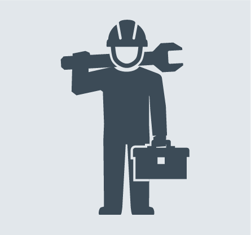Keeping up with the speed of commerce today requires every aspect of the supply chain to be efficient and cost-effective. As a result, companies are looking at numerous ways to compete in this market. One of the most fundamental and impactful is to create and encourage a safe work environment. This will result in a safer work environment, more engaged employees, improved operational performance and reduced maintenance costs.

In warehousing, safety-first means that every inch of space in the facility must meet guidelines and operators must be trained on the proper way to operate all equipment, including forklifts. While forklifts make up just 1% of all accidents that occur in factories or warehouses, the resulting injuries account for 10% of all the physical injuries that take place, making forklift safety training especially important.
It is also the law. Safety training is federally regulated and required by OSHA before any candidate or employee is allowed on the warehouse floor. OSHA also estimates that 70% of all forklift accidents in the U.S. could be avoided with proper training and policies in place.

How can you make forklift safety a top priority in your warehouse? Here are some tips to help you get started:
Implement a comprehensive training program
It is important for operators to understand the business they are going to be working in, especially if it is a career change for new employees. A robust training program is required to comply with OSHA’s standards. It is vital to provide operators with the following:
Classroom training

Use the face-to-face setting to teach employees the basics of forklifts and outline the equipment’s limitations. Provide detailed operating instructions and explain the differences between the Powered Industrial Truck (PIT) and automobiles. Go over PIT controls and instrumentation, so operators know where they are located and what they do.
Teach employees proper steering and maneuvering as well as what restricted visibility they can expect when driving a forklift. Highlight techniques for keeping the vehicle stable and avoiding site and pedestrian hazards. Break down the process of loading and traveling with a load. Make sure operators know the requirements of each product and their unique challenges. For example, liquids, low weight, bulky products, loose materials, and damaged pallets require special attention.
Hands on experience
Show employees the warehouse floor, so they can see firsthand what the job entails. In the warehouse, you can demonstrate what a typical day of operations looks like for operators. This provides an understanding of the environment, as not every warehouse is the exact same. Trainees are also able to see the pace of the atmosphere they will be working in. For example, in the beginning it is especially important to keep trucks at low speed (3-5 mph) to help operators build confidence maneuvering the forklift.
Continuous development opportunities
Throughout an employee’s career, it is essential to foster open communication. Focus on constant coaching, known as behavior-based safety, to help employees handle variances in normal operations with thoughtful advice. Support employees by continuing to communicate to operators what they are doing well and what they are doing that could be harmful. This feedback allows operators to correct behaviors that could impact safety. Encourage operators to stop, think, and ask when they are unsure.
Design your warehouse with safety in mind

When considering warehouse design, one of the primary goals is to reduce the number of interactions between pedestrians and forklifts. Put simply, forklifts are not able to stop on a dime, and striking a pedestrian leads to catastrophic injuries. To mitigate the risk of collisions, establish a designated area for pedestrians and make aisles one way. It is also critical to direct employees with signage on the warehouse floor. Put up stop signs, paint lines, and visually indicate driving direction.

You should also stock inventory strategically and put fast moving products at floor level, so they are easily accessible. This leads to less intrusion on other workers and forklifts. To prevent racks from crushing operators, design your warehouse racks properly. Use the right type of rack, including spacing and height, in accordance with the type of equipment you are using. Installing the racks at the same height as the forklift cab stops operators from going under the racking with standup trucks, which reduces the likelihood of an accident.
Properly maintain equipment
Since different forklift models have their own specifications, there are precautions for the different types of trucks employees will be operating. Therefore, it is necessary to offer training for specific equipment. OSHA standards account for offering training on the exact model of forklift, and operator’s manuals will have special criteria for training.

Your warehouse will also need to keep up with equipment changes. When equipment is modified or enhanced, be sure to offer further training opportunities for operators. For all forklifts, enforce pre-shift inspections. Have employees check to make sure the equipment operates to specifications, the attachment on the front matches the forklift model, the forklift is up-to-date on maintenance for critical elements like brakes and accelerators, and the forklift is fueled/charged.
Like any piece of motorized equipment, it is a legal requirement to train employees on the proper techniques to safely operate forklifts. It is also important to keep equipment well-maintained and include safe measures in the design of your facility. With a solid process for training and ongoing coaching, forklifts can safely drive efficiency in your warehouse.
And, creating and encouraging a safety-first culture will result in safer work environment, more engaged employees and will also improve operational efficiency and reduce maintenance costs.
A big reason why companies outsource is for cost reduction and managing risk. A large part of enterprise quality management is risk management. 3PLs look at how every aspect of the operation impacts each other. Every function, whether shipping, receiving, inventory management, or even support functions like HR and safety, can impact quality. With this comprehensive view, leaders within a 3PL are able to create procedures and identify actions for mitigating risk. 3PLs have a greater level of visibility to address problems and see trends within a company’s supply chain. With this system, reports relating to quality can easily be generated and shared with executive leadership to quickly address negative trends and improve customer experience.
Rather than struggling to manage spreadsheets and get the entire organization on the same page, enterprise quality management systems streamline the process. With this platform, organizations are able to communicate better, manage change, improve access and accountability, and boost productivity. 3PLs take on risk for clients and are able to provide a comprehensive view of quality with an enterprise system. With an ever increasing focus on industry and standard changes bringing quality to the forefront in a growing number of markets, having a robust platform that allows the entire organization to focus on quality initiatives becomes more imperative.



